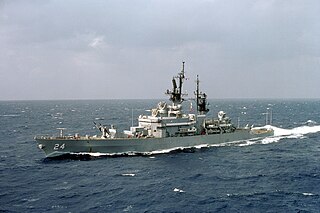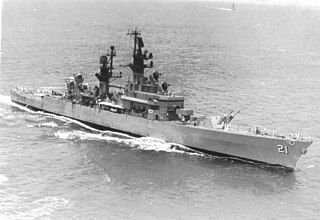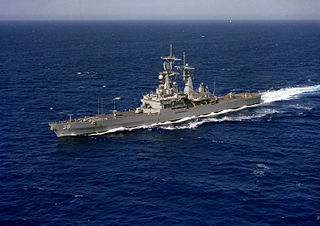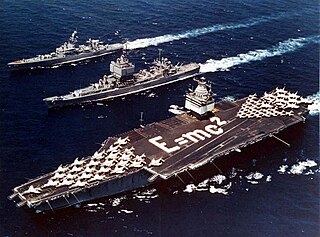
USS Long Beach (CLGN-160/CGN-160/CGN-9) was a nuclear-powered guided missile cruiser in the United States Navy and the world's first nuclear-powered surface combatant. She was the third Navy ship named after the city of Long Beach, California.

USS Reeves (DLG/CG-24), a United States Navy ship named after Admiral Joseph Mason Reeves, was a Leahy-class cruiser built by the Puget Sound Naval Shipyard, in Bremerton, Washington.

USS Gridley (DLG-21/CG-21), a Leahy-class guided missile cruiser, was the third ship of the United States Navy to be named after Charles Vernon Gridley, who distinguished himself with Admiral George Dewey's force at the Battle of Manila Bay on 1 May 1898.

USS Bainbridge (DLGN-25/CGN-25) was a nuclear-powered guided missile cruiser in the United States Navy, the only ship of her class. Named in honor of Commodore William Bainbridge, she was the fourth US Navy ship to bear the name. With her original hull classification symbol of DLGN, she was the first nuclear-powered destroyer-type ship in the US Navy, and shared her name with the lead ship of the first US Navy destroyer class, the Bainbridge-class destroyers.

The Spruance-class destroyer was developed by the United States to replace the many World War II–built Allen M. Sumner- and Gearing-class destroyers, and was the primary destroyer built for the U.S. Navy during the 1970s and 1980s. It was named in honor of United States Navy Admiral Raymond A. Spruance, who successfully led major naval battles in the Asiatic-Pacific Theater during World War II such as the Battle of Midway and Battle of the Philippine Sea.

The Charles F. Adams class is a ship class of 29 guided missile destroyers (DDG) built between 1958 and 1967. Twenty-three were built for the United States Navy, three for the Royal Australian Navy, and three for the West German Bundesmarine. The design of these ships was based on that of Forrest Sherman-class destroyers, but the Charles F. Adams class were the first class designed to serve as guided missile destroyers. 19 feet (5.8 m) of length was added to the center of the design of the Forrest Sherman class to carry the ASROC launcher. The Charles F. Adams-class were the last steam turbine-powered destroyers built for the U.S. Navy. Starting with the succeeding Spruance-class, all U.S. Navy destroyers have been powered by gas turbines. Some of the U.S. Charles F. Adams class served during the blockade of Cuba in 1962 and during the Vietnam War; those of the Royal Australian Navy served during the Vietnam War and Gulf War.

USS Leahy (DLG/CG-16) was the lead ship of a new class of destroyer leaders in the United States Navy. Named for Fleet Admiral William D. Leahy, she was commissioned on 4 August 1962 as DLG-16, a guided missile frigate, and reclassified as CG-16, a guided missile cruiser, on 30 June 1975.

The Virginia-class,, were four nuclear-powered, guided-missile cruisers, that served in the United States Navy until the mid-to-late 1990s. The double-ended cruisers,, were commissioned between 1976 and 1980. They were the final class of nuclear-powered cruisers completed and the last ships ordered as Destroyer Leaders under the pre-1975 classification system.

USS Harry E. Yarnell (DLG/CG-17) was a Leahy-class guided missile cruiser of the United States Navy. Named in honor of Admiral Harry E. Yarnell (1875–1959), she was originally classified as a "destroyer leader" or frigate, in 1975 she was redesignated a cruiser in the Navy's ship reclassification. She was the second of the "double-end" Leahy-class guided missile frigates to join the fleet.

The California class was a pair of two nuclear-powered guided missile cruisers operated by the United States Navy between 1974 and 1998. Other than their nuclear power supply and lack of helicopter hangars, ships of the California class were comparable to other guided missile cruisers of their era, such as the Belknap class. The class was built as a follow-up to the nuclear-powered Long Beach, Bainbridge, and Truxtun classes. Like all of the nuclear cruisers, which could steam for years between refuelings, the California class was designed in part to provide high endurance escort for the navy's nuclear aircraft carriers, which were often limited in range due to their conventionally powered escorts continuously needing to be refueled.

USS Fox (DLG-33/CG-33) was a Belknap class cruiser of the United States Navy, named after Gustavus V. Fox, President Abraham Lincoln's Assistant Secretary of the Navy. The keel for DLG-33 was authenticated and laid in ceremonies at Todd Shipyards, Los Angeles Division, San Pedro, California on 15 January 1963.

Destroyer leader (DL) was the United States Navy designation for large destroyers from 9 February 1951 through the early years of the Cold War. United States ships with hull classification symbol DL were officially frigates from 1 January 1955 until 1975. The smaller destroyer leaders were reclassified as destroyers and the larger as cruisers by the United States Navy 1975 ship reclassification so destroyer escorts could be reclassified as frigates (FF) in conformance with international usage of the term.

New Threat Upgrade (NTU) was a United States Navy program to improve and modernize the capability of existing cruisers and destroyers equipped with Terrier and Tartar anti-aircraft systems, keeping them in service longer. It was a key component of then-President Ronald Reagan's 600-ship Navy plan.

The Belknap-class cruiser was a class of single-ended guided missile cruisers built for the United States Navy during the 1960s. They were originally designated as DLG frigates, but in the 1975 fleet realignment, they were reclassified as guided missile cruisers (CG).

The Albany-class guided missile cruisers were converted Baltimore and Oregon City-class heavy cruisers of the United States Navy. All original superstructure and weapons were removed and replaced under project SCB 172. The converted ships had new very high superstructures and relied heavily on aluminum to save weight.

The RIM-67 Standard ER (SM-1ER/SM-2ER) is an extended range surface-to-air missile (SAM) and anti ship missile originally developed for the United States Navy (USN). The RIM-67 was developed as a replacement for the RIM-8 Talos, a 1950s system deployed on a variety of USN ships, and eventually replaced the RIM-2 Terrier as well, since it was of a similar size and fitted existing Terrier launchers and magazines. The RIM-66 Standard MR was essentially the same missile without the booster stage, designed to replace the RIM-24 Tartar. The RIM-66/67 series thus became the US Navy's universal SAM system, hence the "Standard Missile" moniker.

In the early 1960s, the United States Navy was the world's first to have nuclear-powered cruisers as part of its fleet. The first such ship was USS Long Beach (CGN-9). Commissioned in late summer 1961, she was the world's first nuclear-powered surface combatant. She was followed a year later by USS Bainbridge (DLGN-25). While Long Beach was a 'true cruiser', meaning she was designed and built as a cruiser, Bainbridge began life as a frigate, though at that time the Navy was using the hull code "DLGN" for "destroyer leader, guided missile, nuclear". This was prior to the enactment of the 1975 ship reclassification plan, in which frigates (DLG/DLGN), which were essentially large destroyers, were reclassified as cruisers, so that the US Navy's numbers would compete with those of the Soviet Navy. Long Beach, the largest of all the nuclear cruisers, was equipped with a C1W cruiser reactor, while all the others were equipped with D2G destroyer reactors.

AN/SPS-10 is a two-dimensional radar manufactured by Raytheon Technologies. It was used by the US Navy as a surface-search radar after World War II, and was equipped aboard naval ships during the Cold War. Variants include AN/SPS-10B, AN-SPS/10E and AN/SPS-10F.






















